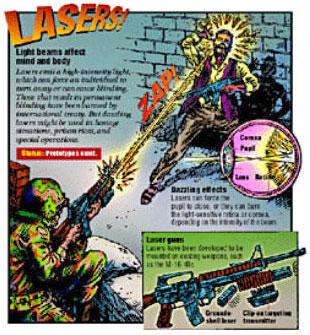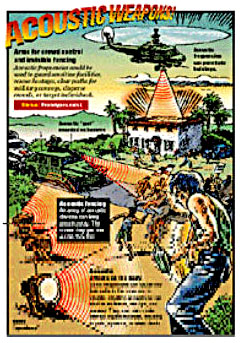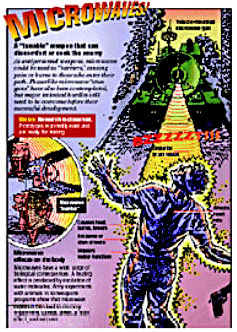|
by Douglas Pasternak from USNews Website
Tucked away in the corner of a drab industrial park in Huntington Beach, Calif., is a windowless, nondescript building. Inside, under extremely tight security, engineers and scientists are working on devices whose ordinary appearance masks the oddity of their function.
One is cone shaped, about the size of a fire hydrant. Another is a 3-foot-long metal tube, mounted on a tripod, with some black boxes at the operator's end. These are the newest weapons of war. For hundreds of years, sci-fi writers have imagined weapons that might use energy waves or pulses to knock out, knock down, or otherwise disable enemies - without necessarily killing them.
And for a good 40 years the U.S. military has quietly been pursuing weapons of this sort. Much of this work is still secret, and it has yet to produce a usable "nonlethal" weapon. But now that the cold war has ended and the United States is engaged in more humanitarian and peacekeeping missions, the search for weapons that could incapacitate people without inflicting lethal injuries has intensified.
Police, too, are keenly interested. Scores of new contracts have been let, and scientists, aided by government research on the "bioeffects" of beamed energy, are searching the electromagnetic and sonic spectrums for wavelengths that can affect human behavior. Recent advancements in miniaturized electronics, power generation, and beam aiming may finally have put such pulse and beam weapons on the cusp of practicality, some experts say. Weapons already exist that use lasers, which can temporarily or permanently blind enemy soldiers.
So-called acoustic or sonic weapons, like the ones in the aforementioned lab, can vibrate the insides of humans to stun them, nauseate them, or even "liquefy their bowels and reduce them to quivering diarrheic messes," according to a Pentagon briefing. Prototypes of such weapons were recently considered for tryout when U.S. troops intervened in Somalia.
Other, stranger effects also have been explored, such as using electromagnetic waves to put human targets to sleep or to heat them up, on the microwave-oven principle. Scientists are also trying to make a sonic cannon that throws a shock wave with enough force to knock down a man.
While this and similar weapons may seem far-fetched, scientists say they are natural successors to projects already underway - beams that disable the electronic systems of aircraft, computers, or missiles, for instance.
That's because the human body is essentially an electrochemical system, and devices that disrupt the electrical impulses of the nervous system can affect behavior and body functions.
But these programs - particularly those involving antipersonnel research - are so well guarded that details are scarce.
Projects underway
To learn what the Pentagon has been
doing, U.S. News talked to more than 70 experts and scoured biomedical and
engineering journals, contracts, budgets, and research proposals. The effort
to develop exotic weapons is surprising in its range. Scores of projects are
underway, most with funding of several hundred
One Air Force lab plans to spend more than $100 million by 2003 to research the "bioeffects" of such weaponry. The benefits of bloodless battles for soldiers and law enforcement are obvious. But the search for new weapons - cloaked as they are in secrecy - faces hurdles.
One is the acute skepticism of many conventional-weapons experts.
Says Charles Bernard, a former Navy weapons-research director:
And if they do work, other problems arise.
Some so-called nonlethal weapons could end up killing rather than just disabling victims if used at the wrong range. Others may easily be thwarted by shielding. Sterner warnings come from ethicists. Years ago the world drafted conventions and treaties to attempt to set rules for the use of bullets and bombs in war.
But no treaties govern the use of unconventional weapons. And no one knows what will happen to people exposed to them over the long term. Moreover, medical researchers worry that their work on such things as the use of electromagnetic waves to stimulate hearing in the deaf or to halt seizures in epileptics might be used to develop weaponry.
In fact, the military routinely has approached the National Institutes of Health for research information.
Still, the Pentagon plans to conduct human testing with lasers and acoustics in the future, says Charles Swett, an assistant for Special Operations and Low-Intensity Conflict. Swett insists that the testing will be constrained and highly ethical. It may not be far off.
The U.S. Air Force expects to have microwave weapons by the year 2015 and other nonlethal weaponry sooner.
What happened with U.S. forces in Somalia
foreshadows the impending ethical dilemmas. In early 1995, some U.S. marines
were supplied with so-called dazzling lasers. The idea was to inflict as
little harm as possible if Somalis turned hostile. But the marines'
commander then decided that the lasers should be
With their intensity thus diminished, they could be used only for designating or illuminating targets. On March 1, 1995, commandos of U.S. Navy SEAL Team 5 were positioned at the south end of Mogadishu airport. At 7 a.m., a technician from the Air Force's Phillips Laboratory, developer of the lasers, used one to illuminate a Somali man armed with a rocket-propelled grenade.
A SEAL sniper shot and killed the Somali. There was no question the Somali was aiming at the SEALs.
But the decision not to use the laser to dazzle or temporarily blind the man irks some of the nonlethal-team members.
Despite such arguments, the International Red Cross and Human Rights Watch have since led a fight against antipersonnel lasers.
In the fall of 1995, the United States signed a treaty that prohibits the development of lasers designed "to cause permanent blindness." Still, laser weapons are known to have been developed by the Russians, and proliferation is a big concern. Also, the treaty does not forbid dazzling or "glare" lasers, whose effects are temporary.
U.S. military labs are continuing work in this
area, and commercial contractors are marketing such lasers to police.
The next debate may well focus on acoustic or sonic weapons. Benign sonic effects are certainly familiar, ranging from the sonic boom from an airplane to the ultrasound instrument that "sees" a baby in the uterus.
The military is looking for something less benign - an acoustic weapon with frequencies tunable all the way up to lethal. Indeed, Huntington Beach-based Scientific Applications & Research Associates Inc. (SARA) has built a device that will make internal organs resonate: The effects can run from discomfort to damage or death.
If used to protect an area, its beams would make intruders increasingly uncomfortable the closer they get.
Such acoustic fences, he says, could be deployed today. He estimates that five to 10 years will be needed to develop acoustic rifles and other more exotic weapons, but adds,
The military also envisions acoustic fields being used to control riots or to clear paths for convoys. SARA's acoustic devices have already been tested at the Camp Pendleton Marine Corps Base, near the company's Huntington Beach office.
And they were considered for Somalia.
But the Department of Defense said, "No," since they were still untested.
The Pentagon feared they could have caused permanent injury to pregnant women, the old, or the sick. Parhami sees acoustics "as just one more tool" for the military and law enforcement.
Toward the end of World War II, the Germans were reported to have made a different type of acoustic device. It looked like a large cannon and sent out a sonic boom-like shock wave that in theory could have felled a B-17 bomber.
In the mid-1940s, the U.S. Navy created a program called Project Squid to study the German vortex technology. The results are unknown. But Guy Obolensky, an American inventor, says he replicated the Nazi device in his laboratory in 1949. Against hard objects the effect was astounding, he says: It could snap a board like a twig.
Against soft targets like people, it had a different effect.
The idea seemed to founder for years until recently, when the military was intrigued by its nonlethal possibilities. The Army and Navy now have vortex projects underway.
The SARA lab has tested its prototype device at
Camp Pendleton, one source says.
The Soviets were known to have potent blinding lasers. They were also feared to have developed acoustic and radio-wave weapons. The 1987 issue of Soviet Military Power, a cold war Pentagon publication, warned that the Soviets might be close to "a prototype short-range tactical RF [radio frequency] weapon."
The Washington Post reported that year that the Soviets had used such weapons to kill goats at 1 kilometer's range.
The Pentagon, it turns out, has been pursuing similar devices since the 1960s.
Typical of some of the more exotic proposals are those from Clay Easterly. Last December, Easterly - who works at the Health Sciences Research Division of Oak Ridge National Laboratory - briefed the Marine Corps on work he had conducted for the National Institute of Justice, which does research on crime control.
One of the projects he suggested was an electromagnetic gun that would "induce epileptic-like seizures."
Another was a "thermal gun [that] would have the operational effect of heating the body to 105 to 107" degrees Fahrenheit.
Such effects would bring on discomfort, fevers, or even death. But, unlike the work on blinding lasers and acoustic weapons, progress here has been slow. The biggest problem is power. High-powered microwaves intended to heat someone standing 200 yards away to 105 degrees Fahrenheit may kill someone standing 10 yards away.
On the other hand, electromagnetic fields weaken quickly with distance from the source. And beams of such energy are difficult to direct to their target.
Mission Research Corp. of Albuquerque, N.M., has used a computer model to study the ability of microwaves to stimulate the body's peripheral nervous system.
But, it concludes,
Nonetheless, government laboratories and private contractors are pursuing numerous similar programs. A 1996 Air Force Scientific Advisory Board report on future weapons, for instance, includes a classified section on a radio frequency or "RF Gunship."
Other military documents confirm that radio-frequency antipersonnel weapons programs are underway. And the Air Force's Armstrong Laboratory at Brooks Air Force Base in Texas is heavily engaged in such research.
According to budget documents, the lab intends to spend more than $110 million over the next six years,
Low-frequency sleep
From 1980 to 1983, a man named Eldon Byrd ran the Marine Corps Nonlethal Electromagnetic Weapons project. He conducted most of his research at the Armed Forces Radiobiology Research Institute in Bethesda, Md.
Byrd, a specialist in medical engineering and bio-effects, funded small research projects, including a paper on vortex weapons by Obolensky. He conducted experiments on animals - and even on himself - to see if brain waves would move into sync with waves impinging on them from the outside. (He found that they would, but the effect was short lived.)
By using very low frequency electromagnetic radiation - the waves way below radio frequencies on the electromagnetic spectrum - he found he could induce the brain to release behavior-regulating chemicals.
He even ran a small project that used magnetic fields to cause certain brain cells in rats to release histamine. In humans, this would cause instant flulike symptoms and produce nausea.
Byrd never tested any of his hardware in the field, and his program, scheduled for four years, apparently was closed down after two, he says.
Byrd says he was told his work would be unclassified, "unless it works."
Because it worked, he suspects that the program "went black." Other scientists tell similar tales of research on electromagnetic radiation turning top secret once successful results were achieved. There are clues that such work is continuing. In 1995, the annual meeting of four-star U.S. Air Force generals - called CORONA - reviewed more than 1,000 potential projects.
One was called "Put the Enemy to Sleep/Keep the Enemy From Sleeping." It called for exploring "acoustics," "microwaves," and "brain-wave manipulation" to alter sleep patterns.
It was one of only three projects approved for
initial investigation.
As the military continues its search for nonlethal weapons, one device that works on contact has already hit the streets. It is called the "Pulse Wave Myotron." A sales video shows it in action.
A big, thuggish-looking "criminal" approaches a well-dressed woman. As he tries to choke her, she touches him with a white device about the size of a pack of cigarettes.
He falls to the floor in a fetal position, seemingly paralyzed but with eyes open, and he does not recover for minutes.
The Myotron overrides voluntary - but not involuntary - muscle movements, so the victim's vital functions are maintained. Sales are targeted at women, but law enforcement officers and agencies - including the Arizona state police and bailiffs with the New York Supreme Court - have purchased the device, Gunby says.
A special model built for law enforcement, called the Black Widow, is being tested by the FBI, he says.
The U.S. military also has shown interest in the Myotron.
While it could not be done, Gunby says, he nonetheless was warned to keep quiet.
Some say such secrecy is necessary in new-weapons development. But others think it is a mistake.
It should not be long before the evidence is in.
LASERS!
Light beams affect mind and body Lasers emit a high-intensity light, which can force an individual to turn away or cause blinding.
Those that result in permanent blinding have been banned by international treaty. But dazzling lasers might be used in hostage situations, prison riots, and special operations.
Status Prototypes exist. Dazzling effects Lasers can force the pupil to close, or they can burn the light-sensitive retina or cornea depending on the intensity of the beam.
Laser guns Lasers have been developed to be mounted on existing weapons, such as the M-16 rifle.
ACOUSTIC WEAPONS!
Arms for crowd control and invisible fencing Acoustic frequencies could be used to guard sensitive facilities, rescue hostages, clear paths for military convoys, disperse crowds, or target individuals.
Status Prototypes exist.
Acoustic fencing An array of acoustic devices can keep people away. The closer they get, the worse they feel. Acoustic effects on the body Sonic frequencies can cause tiny hair cells in the inner ear to vibrate, creating sensations like motion sickness, vertigo, and nausea.
They can also resonate internal organs resulting
in pain, spasms, or even death.
These arms can knock down people or even aircraft The vortex gun expels a doughnut-shaped shock wave that could knock people down. The gun could also be filled with gases or chemical agents. A vortex ring of pepper spray, for instance, would stun its victims with both a physical blow and a chemical irritant.
Status Prototypes exist.
Vortex technology
The vortex gun fires a doughnut-shaped wave with
a powerful center. Lab tests show vortexes can break wooden boards across a
room. When they strike a person, the effect is like being hit with a heavy
blanket.
A "tunable" weapon that can discomfort or cook the
enemy
Status Research is classified. Prototypes reportedly exist and are ready for testing.
Microwave effects on the body Microwaves have a wide range of biological consequences. A heating effect is produced by excitation of water molecules.
Army experiments with animals in non-weapons
programs show that microwave exposure can lead to memory impairment, cardiac
arrest, a "stun" effect, and evoked body movements.
|

 thousand
dollars each.
thousand
dollars each.  "de-tuned"
to prevent the chance of their blinding citizens.
"de-tuned"
to prevent the chance of their blinding citizens. 
